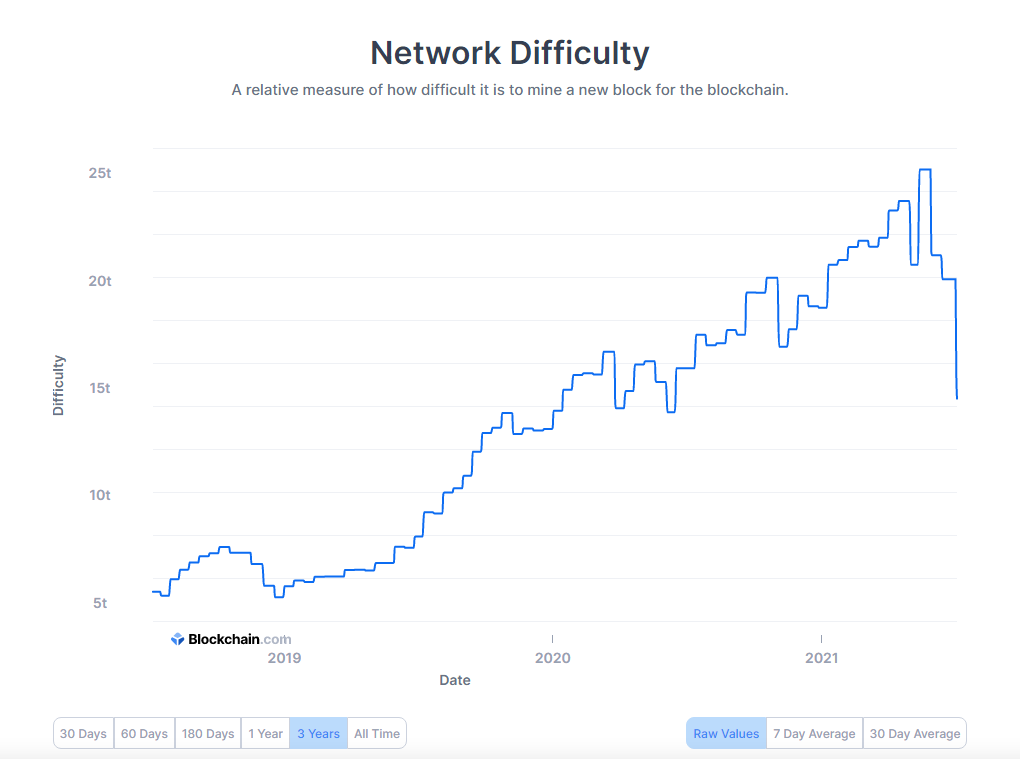Crypto Global
Adjusting the difficulty
Jul 6, 2021
Bitcoin mining has now become easier and more profitable as the difficulty was adjusted after the crypto crackdown in China.
The Bitcoin blockchain has seen the biggest decline in mining difficulty of all time. And that certainly has something to do with the fact that China made it clear about 2 weeks ago that it will not have Bitcoin mining in the country. For this reason, many miners (around 90 percent) have already left China or are about to do so. The result is that the hash rate of the Bitcoin network drops, which is the total amount of computing power used to solve blocks and secure the network.


Source: https://www.blockchain.com/charts/difficulty

Source: https://www.blockchain.com/charts/hash-rate
The reason this is important is because there is very little understanding of how hash rate works as a market mechanism. What we will now see is that it becomes cheaper to generate a Bitcoin when the hash rate and the difficulty decrease. The result is that the miners are still doing fine right now, even though the Bitcoin price has dropped sharply, and that's because of this drop in the hash rate. The hash rate and mining difficulty are therefore a very special kind of dynamic in Bitcoin. In this article, we want to explain this most interesting feature of Bitcoin to you.
To understand what mining difficulty is, let's look again at the problem that blockchains are trying to solve. And that is building consensus among a number of computers or nodes on the Internet. In the case of a cryptocurrency, this is the agreement on how individual users spent their coins. It may not seem like it, but this is a challenge to be solved. Some computers on a network are not always honest and can go away at any time. When one wants to join a network, a computer goes on the Internet and looks for another participating computer to join the longest chain. As a new participant you don't know which computer to trust because anyone could try to trick the system in order to enrich themselves. So you don't know whether the longest chain alone is the right one. To solve this problem, Satoshi slowed down the process of creating new blocks using the proof-of-work algorithm. It's almost like a lottery, in which a computer performs a series of random calculations to try to be the first to solve a cryptographic puzzle. Your chances of solving it are pretty slim. Every computer tries a lot of combinations, but in the end only one can solve it first. And when that happens, you have to start over to create the next block. On average there is a computer every 10 minutes that solves the puzzle and receives the mining reward, which is distributed in Bitcoin, for creating a new block. This 10 minute time delay makes it impossible to artificially create the longest chain, as the likelihood that your computer alone can solve the puzzle in time is very unlikely. There is one major problem with this, and it is that computers get faster over time, so newer computers can do more calculations and possibly create blocks in less than 10 minutes.
And that brings us to the "difficulty" of mining: The difficulty of the cryptocurrency is a measure of how difficult it is to mine a block in a blockchain for a specific cryptocurrency. The difficulty is not a fixed number. It is automatically adjusted every 2016 block. The system checks how quickly these blocks were created. Usually this should take exactly two weeks. If more blocks were created during this period, the difficulty increases. If fewer blocks have been created, the difficulty decreases. The reason the difficulty needs to be adjusted every two weeks is because the system needs to balance the number of miners. More miners mean that there is a higher chance that someone will solve the puzzle in less time, which means that the difficulty should be increased to keep it up. In summary, adjusting the difficulty ensures that mining new blocks always takes around 10 minutes, no matter how fast our computers are and no matter how many people mine.
The lowering of the hashrate forced by China in combination with the enormously reduced difficulty could lead Bitcoin into a golden era of mining and develop into a stronger, decentralized mining network in the short and medium term.